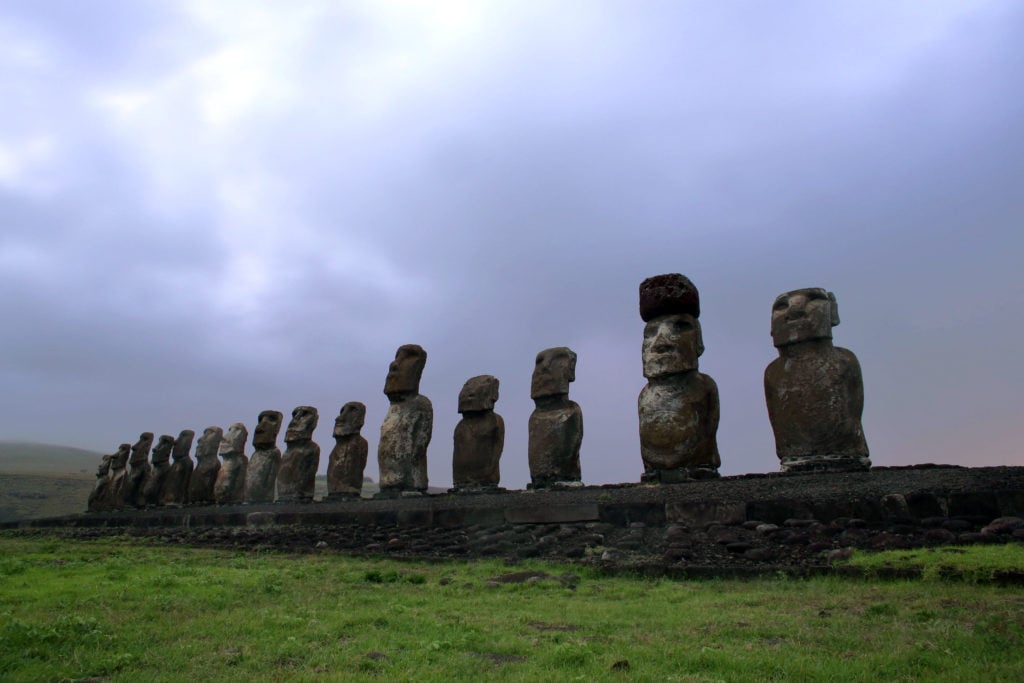Art World
The British Museum Has Kept an Easter Island Statue for 150 Years. Now, the Rapa Nui People Want It Back
The seven-foot-tall statue is considered a sacred object by the local people.

The seven-foot-tall statue is considered a sacred object by the local people.

Naomi Rea

The Rapa Nui people, the indigenous population of Easter Island, have enlisted the help of the Chilean government to petition the return of a monumental Moai statue from the British Museum.
The seven-foot-tall statue, called Hoa Hakananai’a, which translates to “the stolen or hidden friend,” is considered a sacred object by the local people. In the Rapa Nui culture, the Moai sculptures are believed to be inhabited by protective spirits or mana.
The statue was removed from the island in 1868 by a Royal Navy captain, Richard Powell, and presented as a gift to Queen Victoria. She donated it to the national museum in London in 1869. The sculpture is rare because it is one of only a few examples of Moai made from basalt; the other 900-some sculptures on the island, made in the 16th and 17th centuries, were constructed with volcanic ash. Etched into its back are figures associated with the Tangata Manu, or the “bird man” cult.
Although the Rapa Nui people took control of the conservation, preservation, and management of their archeological heritage in December 2017, Chile’s national treasures minister Felipe Ward, told AFP on Tuesday that the request for Chile’s help “seems appropriate given the new coordination and conservation functions being carried out on the island with regards the Moai.”
A spokesperson for the British Museum told artnet News that the museum is not aware of an official request for the return of the statue from the Rapa Nui people, the Easter Island Development Commission, or the Chilean government. The representative underscored the educational value of displaying the sculpture at the museum.
“We believe that there is great value in presenting objects from across the world, alongside the stories of other cultures at the British Museum,” the spokesperson said. “Hoa Hakananai’a is free to view in our Wellcome Trust Gallery and is among the most popular and most photographed exhibits with our 6 million visitors each year.”

The Moai at the British Museum. Image courtesy Kevan via Flickr.
Asked how the museum might respond to a request for the return of the sculpture to Easter Island, the spokesperson noted that the museum is one of the world’s leading lenders and that the Trustees will always consider loan requests. “We are keen to work collaboratively with partners and communities across the globe and welcome any specific proposals and discussions around future joint project and research work.”
This is not the first time the Chilean government has been called upon to help the Rapa Nui get their statue back. In 2016, a Chilean documentary filmmaker launched a petition asking the government to demand the return of Rapa Nui artifacts, but until now the Chilean government had not responded positively.
“It’s a unique piece, the only tangible link that accounts for two important stages in our ancestral history,” local Rapa Nui leaders told AFP, adding that recovering the work would be “an important symbol in closing the sad chapter of violation of our rights by European navigators.”
Hoa Hakananai’a is one of an estimated 4,000 artifacts taken from Easter Island since it was first recorded by European navigators in 1777 that are currently in collections around the world. Another Moai statue stands in the Quai Branly museum in Paris, for example.
Easter Island, which is about 2,000 miles off the Chilean coast, was annexed by Chile in 1888, by which time the majority of its population was decimated by European diseases like smallpox or sold into slavery. Earlier this month, the Chilean government made moves to restrict tourism to the island to protect its famous statues and natural environment, reducing the number of days tourists can visit, from 90 to 30. It also fast-tracked a bill seeking to change Easter Island’s name to Rapa Nui.